Users convert abstract spaces into lived spaces by negotiating the socio-cultural values associated with their communities and the desires of different users. This article is based on the study of the transformation of the Danwei community, a work unit associated with a switch manufacturing factory which includes both the factory and residential units of its workers, in a rapidly urbanising town, Changsha in China. Let’s investigate how users of two markets in the community play a huge role in transforming the spaces but not exactly in the way the government or professionals perceive modernity. The focus is on informal production and transformation of spaces to make them work in the way users desire spaces to function and how formal space-making or the planning process ignores small details that make abstract places into lived spaces.
The switch factory is partially closed and another government agency had planned to build a ‘modern neighbourhood’ with new houses and facilities to ‘modernise’ the entire landscape of the community in 2015. It’s a tale of two markets built on either side of the same building. Residents refer to them as the old market and the new market. The old market refers to the informal market developed by the residents of the Danwei community. The new market is the ‘modern’ market complex that is being designed and constructed by the government in the first stage of transforming and modernizing the Danwei community in Changsha. How people face this transition and how they transform the abstract market space (new market) given to them by the government in the new apartment complex into a dynamic place to fulfill their needs over time depicts many stories.
This includes how limited the formal planning process is in creating places to match the user perspectives and desires, how people are not merely passive recipients but active agents of change and transformation and how women adopt places to match their requirements as a formal planning approach fails to see them in the planning process.
These findings are based on a study that was conducted in 2015 as a part of the CapAsia immersive learning programme organised by Ball State University, USA. CapAsia is held around two basic components: a seven-week Planning to Learn component and a three-week Building to Learn component. This year, the three-week component was held in Changsha, China, and the focus was on small spaces. CapAsia students opted to learn about various small spaces that make up the old community. This article is based on my study of the dynamics of the market in Danwei and the new market in the modern neighbourhood the government is planning for its residents.
Old market
Market activities in this location were first recognised in 2003. This place was not designed for a market. Shop spaces that are today used for market activities were once garages rarely used by the residents as most of them did not own vehicles. Some people who owned garages converted them into shops. Residents who could not or did not want to open a shop rented their garages to others who wanted to start a business.
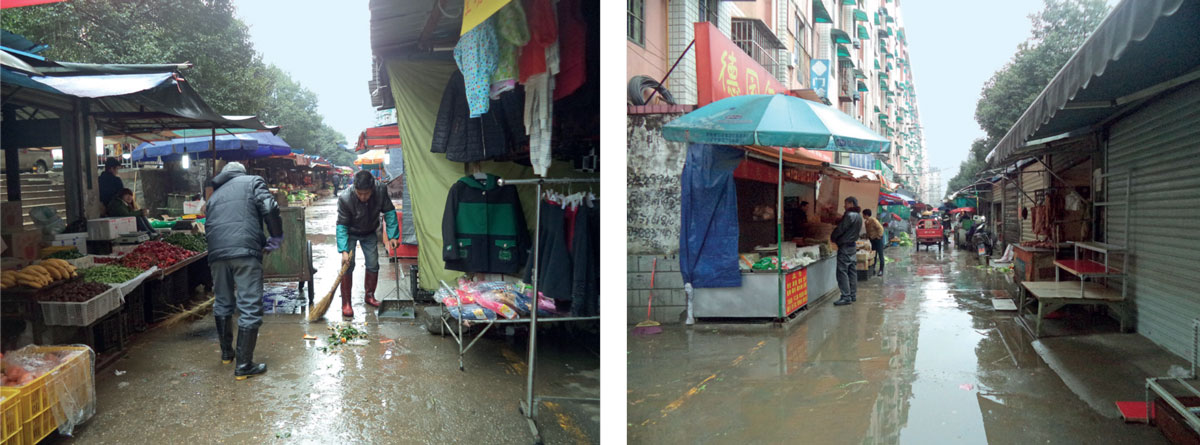
Right: Market side of the building at closing time
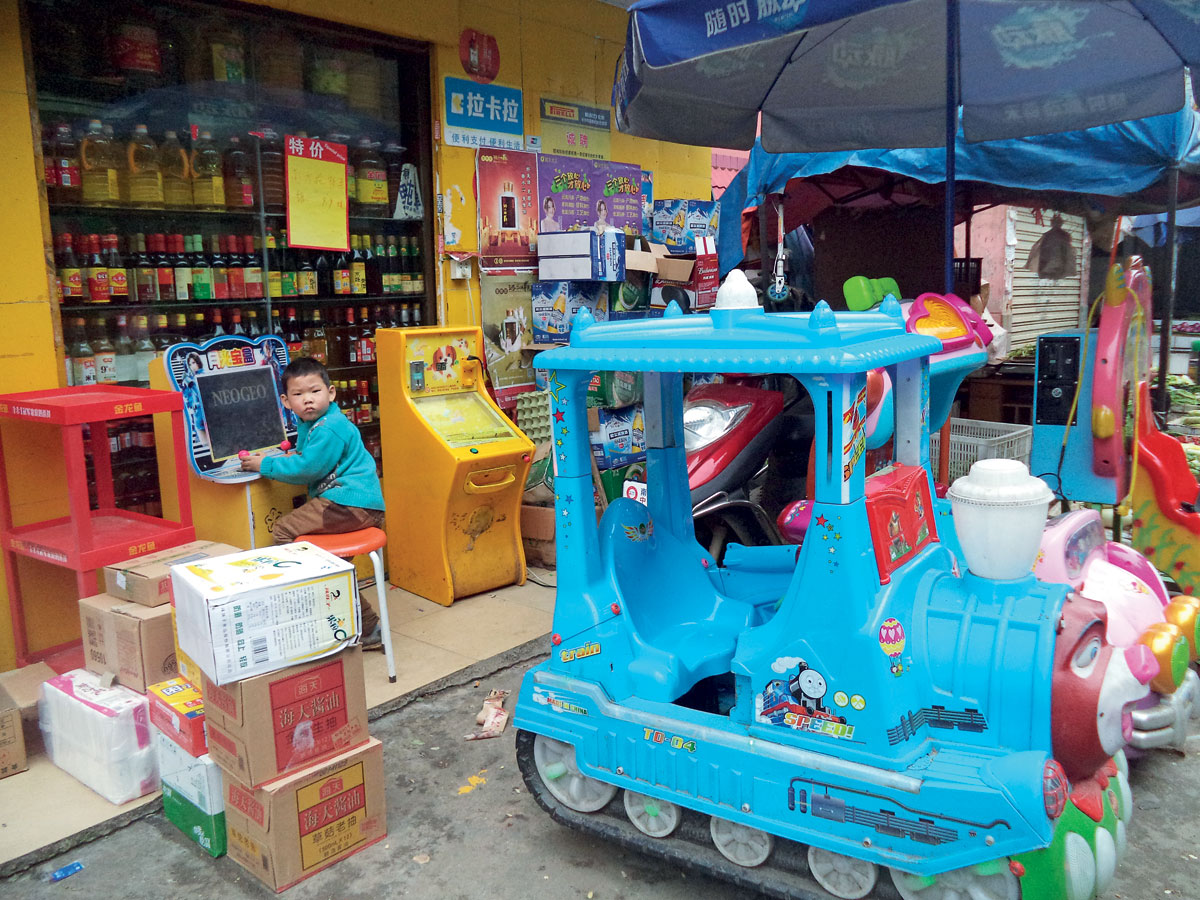
Later, motor bike parks, which were located in front of the garages, were converted by the Danwei as additional market spaces by building small huts. The initiations of the market and its transformation into what it is today were carried out by people themselves. People transformed the abstract space planned by the government for garages into the lived place of the market.
The Danwei management uses the revenue collected from permanent and mobile vendors to manage the market. I noticed that the connection between the old market and the new market – through the Danwei building – is closed, except for one staircase which has been left open. The manager of the Danwei explained that the Danwei closed the gates to oppose the new market. They did not want customers from the old market to access the new market through their building. When the developer asked to open the gates, the community bargained for a very high price, so the developer gave up.
The manager of the Danwei said that only one vendor from the old market moved to the new market due to better facilities but failed to do good business there. Although he decided to return to the old market, he was not welcomed. People are reluctant to welcome the ‘modernised future’ designed by the government. They contest the government’s idea of modernisation and try to maintain their values and living style although they are also in a continuous negotiation with those values and living styles to change and modernise them.
The old market looks very informal and unorganised to an outsider, but there is an underlying system that basically runs all the activities in the market. Although the main decisions are taken by the Danwei, all other important decisions, which give the meaning to the market and shape the place are taken by the users: vendors and shoppers.
I also conducted a participant observation of the old market by working in one of the restaurants there. When the shop got busy during lunchtime, I was left alone to deal with customers. After the customers had eaten, I would put the used plates and cups in a basin in the toilet. If a customer wanted to use the bathroom, shopkeepers allowed them, which amazed me. I expected them to hide the fact that they use the bathroom to clean dishes and vegetables. When I narrated this to the CapAsians, they were worried as they’d had several meals in that restaurant. None of the restaurants in the market has water facilities other than in the bathroom, neither do they have a separate kitchen. It was interesting to know how people created living space from abstract space that they are allotted. Use of space or transformation is not an individual choice but also follows community values. If customers refused to have their plates washed in the same toilet they use, this shop and the market could not function the way they do now.
After lunchtime, a lady who arrived in a small truck went directly to the bathroom and collected the food waste from the trash can there. In return, she gave the restaurant owner some fresh vegetables. This lady went all over the market and collected a truck full of food waste in exchange for vegetables from her cart. When I asked the restaurant owner about the lady, he said she owned a farm nearby where she had vegetables, fruits and livestock. She collected food waste to feed the pigs and exchanged it for produce from her farm.
Knowing how these little activities support the functionality of the community is very important while planning. If this lady didn’t come, it would be hard for the Danwei to manage waste with the little rent it collects and the meager facilities and space available. On the other hand, if the market develops a convenient and sophisticated method of waste management, its higher cost will impact the economic activities of this woman.
Some customers came to the restaurant for lunch with their babies. If and when a baby started to cry, shopkeepers looked after her/ him while the mother finished her meal. This happened a few times; it directed me to observe the relationship between customers and the vendor. They were very friendly with one another, talked and laughed together and spent extra time in the place even after the meal. Most of them were daily customers and knew each other. There was a place for kids to play near the restaurant. Some mothers gave their kids a few coins to pay for the play station after a meal.
These little places and activities have transformed over time. People constantly improve to cater to unmet and changing needs.
Like the children’s play area, the market itself is changing. It is managed by people, operating and transforming it to meet the new demands and changing aspirations, negotiated within changing power structures.
New market
Moving from the old market to the new market was an escape from a humid and cold environment to a neat and clean place. The market was not heated but it was comparatively warmer. At first, I appreciated everything about this market since it was comfortable. The new market has been planned and developed by a real estate developer and opened for the public in January 2015. The place appears new and some shops are yet to open. The market looks well organised. The vegetable and fruit section was separated from the fish and meat section. Groceries, pharmacies, textiles and other shops were located outside the market along the road. Electricity, water, internal drainage, ponds for fish and cages for chickens were designed according to set standards. A very sophisticated mahjong area was also located on this side of the building to the model of a traditional tea house in China.
Many kids played along the new market. Most of them were kids of business-women in the market. As the market was located indoors and there were some empty shops, mothers did not seem to worry about the kids playing on the street front; they did not worry about their safety of their kids. This observation made me examine the demographics of the place. More than half the vendors in the new market were women and most of them had moved to Changsha recently from rural areas. All six women that I spoke to said that in their villages they had been housewives, economically dependent on their husbands who were the only source of income. When they moved to Changsha, the cost of living increased, and they found in this market an opportunity to start a business.
Rural to urban migration has thus changed the gender roles of these women.
In the evenings, husbands who work as masons, security officers and factory workers come to the market instead of going home. Business women still cook for their family. Although it appears that these women were economically empowered and independent after they migrated from rural to urban, they have to perform more roles now. They still perform their roles as mothers and housewives, in addition to earning an additional income for the family. I could not learn more about the different aspects of their gender roles and how they had changed because of the limited time we had in the market.
Planning is patriarchal; so is the design of the markets and other common spaces. This market is designed for men who will come here to work, nothing else, with facilities simply to carry on their business. One could say it is strictly functional, but this view may be biased towards the patriarchal capitalist view of men working and doing nothing else. Women have to bring their kids to work; hence, children’s safety is a significant issue for them, especially since while focusing on their work they may be unable to pay attention to the kids.
Women rely on social capital. Mothers with same-aged kids have developed a network of trust among themselves and with people who are from the same province and speak the same language. All the mothers keep an eye on the kids. Still, I observed that some mothers stop their business and turn their attention from customers to bring back kids who may have gone out of sight. During the time of study, kids are found in empty shops, but they will not have this place if and when all shops are occupied. Planning and design of space should include these gender dimensions and involve women in the decision-making process.
There is an informal gathering place inside the new market. People who gathered there were migrants from the same province in China. The main reason they huddled there was the presence of a heater owned by one of the shop keepers. They also had a kettle and other facilities to make green tea. One day, I volunteered to make tea for them, so I could spend some time with them. There were spaces designed outside the market for public gathering, but I learned how people make new public spaces that match their requirements. Over time, people transform the space to create a sense of belonging. This transformation is through social networking and adaptation of the physical space.
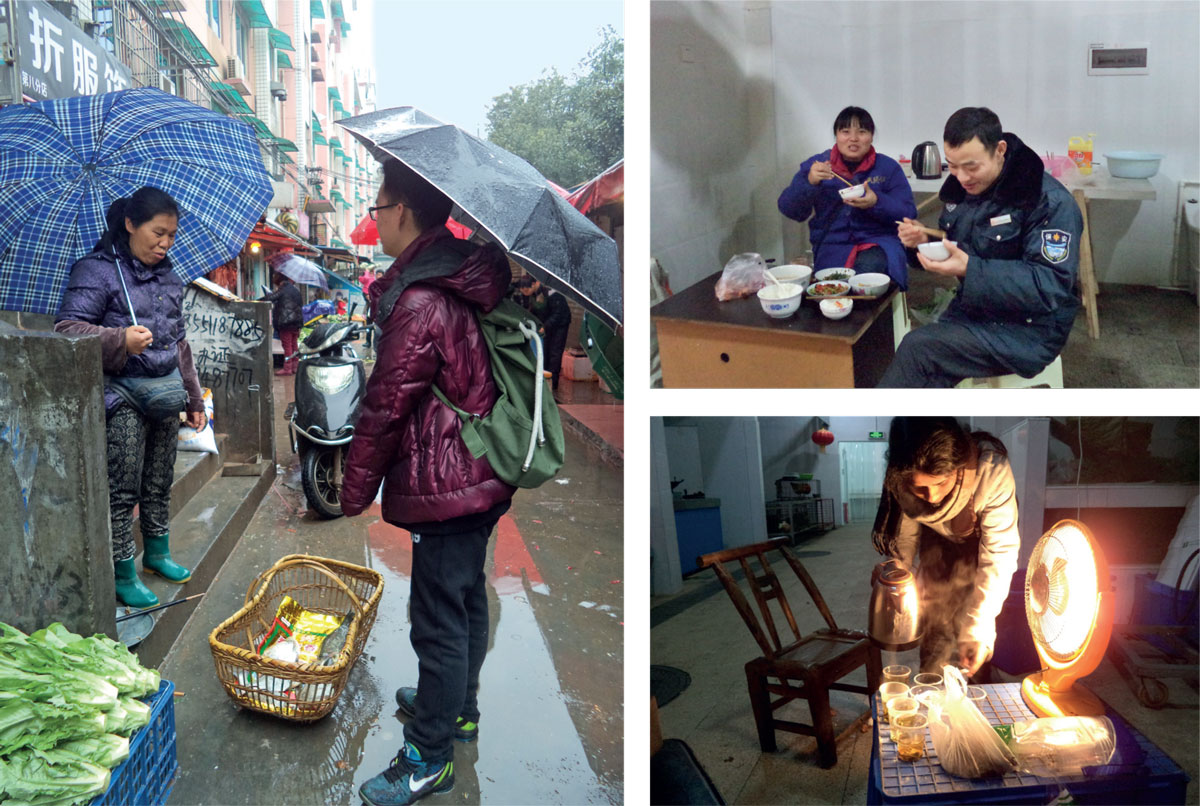
Top Right: In an empty shop, a woman has prepared dinner for her husband who has returned from work
Bottom Right: Researcher making tea at the gathering place
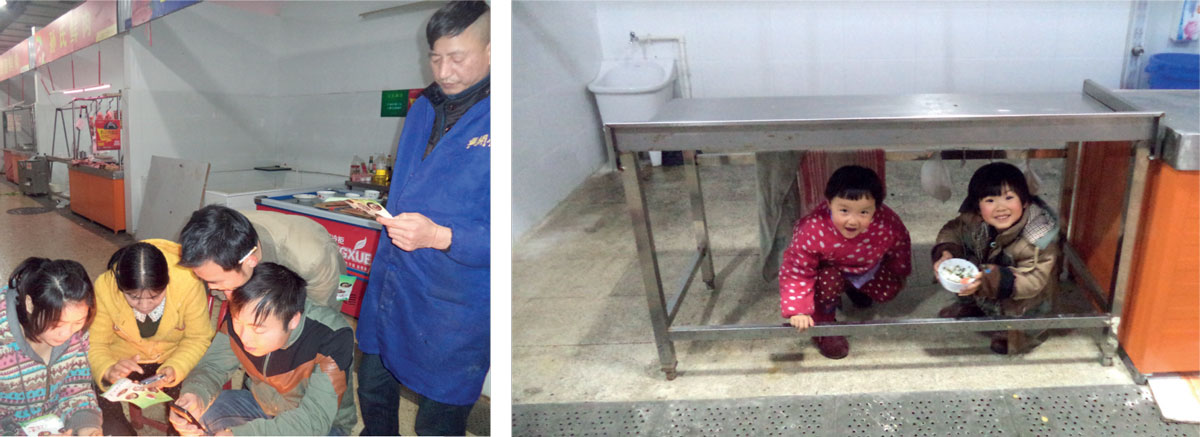
Right: Kids playing at the new market
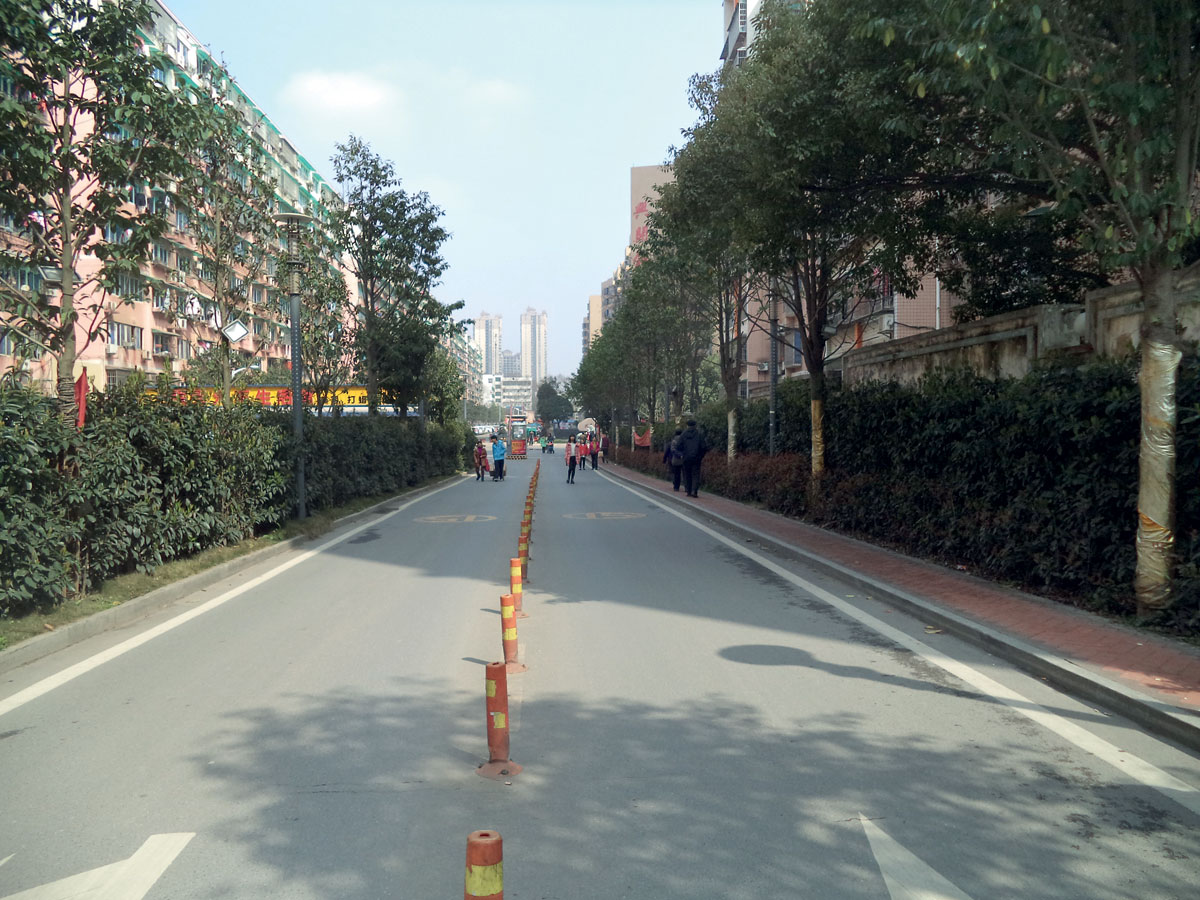
Filling a Gap: Ground level gathering place
Planners conceive space in abstract terms focusing on the main functions. In this market the developer has planned and designed the main necessities to fulfill the requirements of a market place. Yet people have other (secondary and tertiary) needs such as gathering, resting, talking, and getting advice. The design of the place has followed the idea of separating different functions such as working and resting as well as different types of commercial activities such as vegetables, meat and groceries. Outside the market place, planners have designed fountains and a seating area, but these vendors do not have time to sit in these places in order to socialise.
Mostly women and people from the lower middle class cannot separate their work from socialisation. They work and socialize simultaneously and hence use the same space; people have created their own ground level spaces for these needs.
There is one kids’ play station (commercial) operated in front of a grocery store outside this market. The separation of activities has created a very organised, nice-looking place with less functional efficiency for users. Yet mothers do not send their kids to play at that play station since they would’nt be able to keep an eye on their kids like business-women do in the old market. However, they do create ground level spaces such as small gathering places, sleeping spots, smoking areas, baby caring places and cooking facilities to fulfil these needs by themselves. Although the modern market developed by professionals seemed complete to an outsider, ground level spaces illustrated the gap between a planner’s perception of community needs and the real needs and aspirations of people in a market and those needs and aspirations are more complex than a planner can assume.
Conclusion
Although the government believes that people would prefer more facilities and move to the new market space that they designed, there are other small, but intimate relationships and functions that make a space like a market or a community.
Outsiders cannot readily understand the complexities through the categories that the profession has developed to understand a place such as demography, income, education level, land use type or building density.
Users produce, transform and modernise the spaces they use with time. Ordinary people redefine spaces for their needs, which changes over time, giving different meanings to physical space. Users borrow trends from the outside world to restructure their aspirations and negotiate the spaces they desire keeping in mind community values.
Individual aspirations are also negotiated with the community and each and every agent with different power positions has their own ways of negotiating their aspirations with the community. This negotiation between an individual’s aspirations and conflicts with aspirations of others in the community such as selling cigarettes shape the aspirations of the community. Planning should pay more attention to people’s aspirations through their stories and remove the deprivations that communities face in order to help them achieve the development that they wish for.

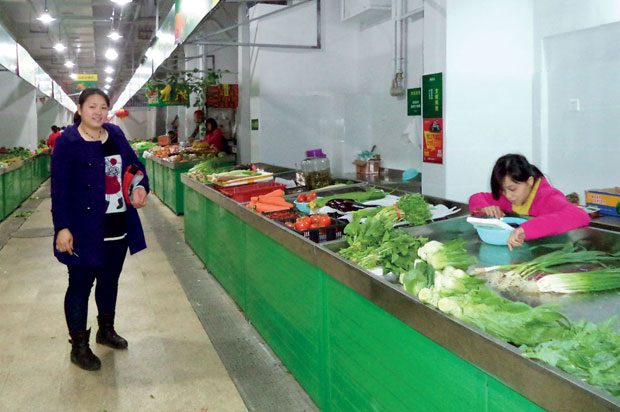

Comments (0)